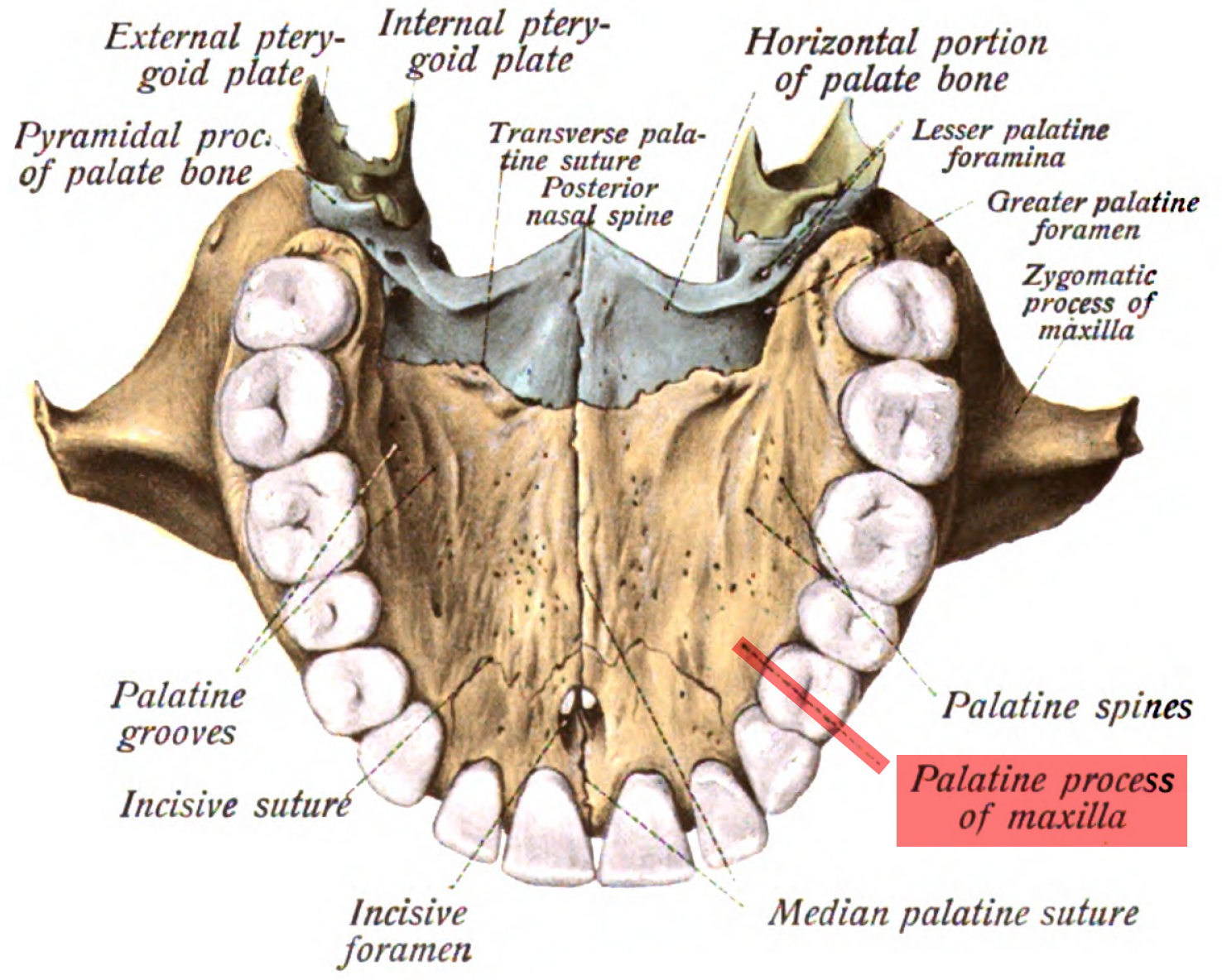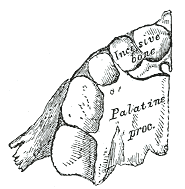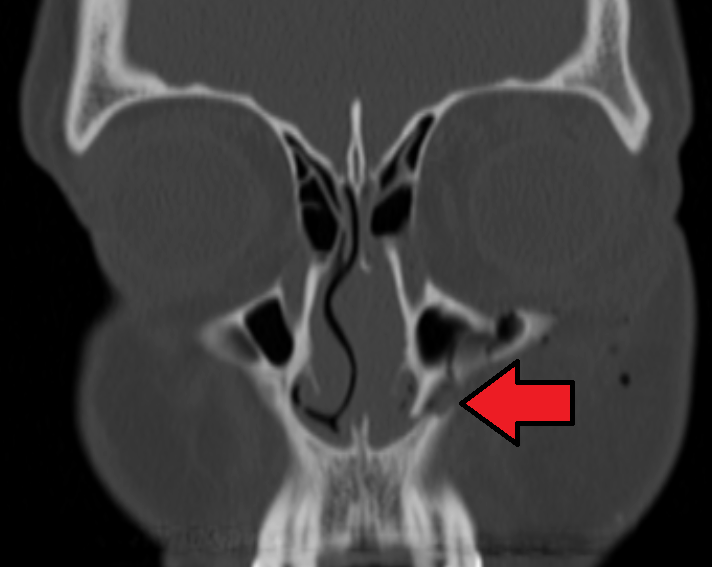Maxillary Bone on:
[Wikipedia]
[Google]
[Amazon]
In
 * The body of the maxilla: pyramid-shaped; has an orbital, a nasal, an infratemporal, and a facial surface; contains the
* The body of the maxilla: pyramid-shaped; has an orbital, a nasal, an infratemporal, and a facial surface; contains the

 The maxilla is ossified in membrane. Mall and Fawcett maintain that it is ossified from ''two'' centers only, one for the maxilla proper and one for the premaxilla.
These centers appear during the sixth week of
The maxilla is ossified in membrane. Mall and Fawcett maintain that it is ossified from ''two'' centers only, one for the maxilla proper and one for the premaxilla.
These centers appear during the sixth week of
 The
The
File:Maxilla anterior.png, Skull. Maxilla shown in green.
Maxilla - animation 02.gif, Skull. Maxilla shown in white.
vertebrate
Vertebrates () are animals with a vertebral column (backbone or spine), and a cranium, or skull. The vertebral column surrounds and protects the spinal cord, while the cranium protects the brain.
The vertebrates make up the subphylum Vertebra ...
s, the maxilla (: maxillae ) is the upper fixed (not fixed in Neopterygii
Neopterygii (from Greek νέος ''neos'' 'new' and πτέρυξ ''pteryx'' 'fin') is a subclass of ray-finned fish (Actinopterygii). Neopterygii includes the Holostei and the Teleostei, of which the latter comprise the vast majority of extant ...
) bone
A bone is a rigid organ that constitutes part of the skeleton in most vertebrate animals. Bones protect the various other organs of the body, produce red and white blood cells, store minerals, provide structure and support for the body, ...
of the jaw
The jaws are a pair of opposable articulated structures at the entrance of the mouth, typically used for grasping and manipulating food. The term ''jaws'' is also broadly applied to the whole of the structures constituting the vault of the mouth ...
formed from the fusion of two maxillary bones. In humans, the upper jaw includes the hard palate
The hard palate is a thin horizontal bony plate made up of two bones of the facial skeleton, located in the roof of the mouth. The bones are the palatine process of the maxilla and the horizontal plate of palatine bone. The hard palate spans ...
in the front of the mouth
A mouth also referred to as the oral is the body orifice through which many animals ingest food and animal communication#Auditory, vocalize. The body cavity immediately behind the mouth opening, known as the oral cavity (or in Latin), is also t ...
. The two maxillary bones are fused at the intermaxillary suture, forming the anterior nasal spine
The anterior nasal spine, or anterior nasal spine of maxilla, is a bony projection in the skull that serves as a cephalometric landmark. The anterior nasal spine is the projection formed by the fusion of the two maxillary bones at the intermaxill ...
. This is similar to the mandible
In jawed vertebrates, the mandible (from the Latin ''mandibula'', 'for chewing'), lower jaw, or jawbone is a bone that makes up the lowerand typically more mobilecomponent of the mouth (the upper jaw being known as the maxilla).
The jawbone i ...
(lower jaw), which is also a fusion of two mandibular bones at the mandibular symphysis
In human anatomy, the facial skeleton of the skull the external surface of the mandible is marked in the median line by a faint ridge, indicating the mandibular symphysis (Latin: ''symphysis menti'') or line of junction where the two lateral ha ...
. The mandible is the movable part of the jaw.
Anatomy
Structure
The maxilla is a paired bone - the two maxillae unite with each other at the intermaxillary suture. The maxilla consists of: * The body of the maxilla: pyramid-shaped; has an orbital, a nasal, an infratemporal, and a facial surface; contains the
* The body of the maxilla: pyramid-shaped; has an orbital, a nasal, an infratemporal, and a facial surface; contains the maxillary sinus
The pyramid-shaped maxillary sinus (or antrum of Nathaniel Highmore (surgeon), Highmore) is the largest of the paranasal sinuses, located in the maxilla. It drains into the middle meatus of the noseHuman Anatomy, Jacobs, Elsevier, 2008, page 209- ...
.
* Four processes:
** the zygomatic process
The zygomatic processes (aka. malar) are three processes (protrusions) from other bones of the skull which each articulate with the zygomatic bone. The three processes are:
* Zygomatic process of frontal bone from the frontal bone
* Zygomatic ...
** the frontal process
** the alveolar process
The alveolar process () is the portion of bone containing the tooth sockets on the jaw bones (in humans, the maxilla and the mandible). The alveolar process is covered by gums within the mouth, terminating roughly along the line of the mandibu ...
** the palatine process
It has three surfaces:
* the anterior, posterior, medial
Features of the maxilla include:
* the infraorbital sulcus, canal
Canals or artificial waterways are waterways or engineered channels built for drainage management (e.g. flood control and irrigation) or for conveyancing water transport vehicles (e.g. water taxi). They carry free, calm surface ...
, and foramen
In anatomy and osteology, a foramen (; : foramina, or foramens ; ) is an opening or enclosed gap within the dense connective tissue (bones and deep fasciae) of extant and extinct amniote animals, typically to allow passage of nerves, artery, ...
* the maxillary sinus
The pyramid-shaped maxillary sinus (or antrum of Nathaniel Highmore (surgeon), Highmore) is the largest of the paranasal sinuses, located in the maxilla. It drains into the middle meatus of the noseHuman Anatomy, Jacobs, Elsevier, 2008, page 209- ...
* the incisive foramen
In the human mouth, the incisive foramen (also known as: "''anterior palatine foramen''", or "''nasopalatine foramen''") is the opening of the incisive canals on the hard palate immediately behind the incisor teeth. It gives passage to blood ves ...
Articulations
Each maxilla articulates with nine bones: frontal,ethmoid
The ethmoid bone (; from ) is an unpaired bone in the skull that separates the nasal cavity from the brain. It is located at the roof of the nose, between the two orbit (anatomy), orbits. The cubical (cube-shaped) bone is lightweight due to a sp ...
, nasal
Nasal is an adjective referring to the nose, part of human or animal anatomy. It may also be shorthand for the following uses in combination:
* With reference to the human nose:
** Nasal administration, a method of pharmaceutical drug delivery
* ...
, zygomatic, lacrimal, and palatine
A palatine or palatinus (Latin; : ''palatini''; cf. derivative spellings below) is a high-level official attached to imperial or royal courts in Europe since Roman Empire, Roman times.
bones, the vomer
The vomer (; ) is one of the unpaired facial bones of the skull. It is located in the midsagittal line, and articulates with the sphenoid, the ethmoid, the left and right palatine bones, and the left and right maxillary bones. The vomer forms ...
, the inferior nasal concha
The inferior nasal concha (inferior turbinated bone or inferior turbinal/turbinate) is one of the three paired nasal conchae in the human nose, nose. It extends horizontally along the lateral wall of the nasal cavity and consists of a wikt:lam ...
, as well as the maxilla of the other side.
Sometimes it articulates with the orbital surface, and sometimes with the lateral pterygoid plate
The pterygoid processes of the sphenoid (from Greek ''pteryx'', ''pterygos'', "wing"), one on either side, descend perpendicularly from the regions where the body and the greater wings of the sphenoid bone unite.
Each process consists of a me ...
of the sphenoid.
Development

 The maxilla is ossified in membrane. Mall and Fawcett maintain that it is ossified from ''two'' centers only, one for the maxilla proper and one for the premaxilla.
These centers appear during the sixth week of
The maxilla is ossified in membrane. Mall and Fawcett maintain that it is ossified from ''two'' centers only, one for the maxilla proper and one for the premaxilla.
These centers appear during the sixth week of prenatal development
Prenatal development () involves the development of the embryo and of the fetus during a viviparous animal's gestation. Prenatal development starts with fertilization, in the germinal stage of embryonic development, and continues in fetal de ...
and unite in the beginning of the third month, but the suture between the two portions persists on the palate until nearly middle life. Mall states that the frontal process is developed from both centers.
The maxillary sinus appears as a shallow groove on the nasal surface of the bone about the fourth month of development, but does not reach its full size until after the second dentition.
The maxilla was formerly described as ossifying from six centers, viz.:
* One, the ''orbitonasal,'' forms that portion of the body of the bone which lies medial to the infraorbital canal, including the medial part of the floor of the orbit and the lateral wall of the nasal cavity.
* A second, the ''zygomatic,'' gives origin to the portion which lies lateral to the infraorbital canal, including the zygomatic process.
* From a third, the ''palatine,'' is developed the palatine process posterior to the incisive canal together with the adjoining part of the nasal wall.
* A fourth, the ''premaxillary,'' forms the incisive bone which carries the incisor teeth and corresponds to the premaxilla of the lower vertebrates.
* A fifth, the ''nasal,'' gives rise to the frontal process and the portion above the canine tooth.
* And a sixth, the ''infravomerine,'' lies between the palatine and premaxillary centers and beneath the vomer; this center, together with the corresponding center of the opposite bone, separates the incisive canals from each other.
Changes by age
At birth the transverse and antero-posterior diameters of the bone are each greater than the vertical. The frontal process is well-marked and the body of the bone consists of little more than the alveolar process, the teeth sockets reaching almost to the floor of the orbit. The maxillary sinus presents the appearance of a furrow on the lateral wall of the nose. In the adult the vertical diameter is the greatest, owing to the development of the alveolar process and the increase in size of the sinus.Function
 The
The alveolar process
The alveolar process () is the portion of bone containing the tooth sockets on the jaw bones (in humans, the maxilla and the mandible). The alveolar process is covered by gums within the mouth, terminating roughly along the line of the mandibu ...
of the maxillae holds the upper teeth, and is referred to as the maxillary arch. Each maxilla attaches laterally to the zygomatic bone
In the human skull, the zygomatic bone (from ), also called cheekbone or malar bone, is a paired irregular bone, situated at the upper and lateral part of the face and forming part of the lateral wall and floor of the orbit, of the temporal fos ...
s (cheek bones).
Each maxilla assists in forming the boundaries of three cavities:
* the roof of the mouth
A mouth also referred to as the oral is the body orifice through which many animals ingest food and animal communication#Auditory, vocalize. The body cavity immediately behind the mouth opening, known as the oral cavity (or in Latin), is also t ...
* the floor and lateral wall of the nasal cavity
The nasal cavity is a large, air-filled space above and behind the nose in the middle of the face. The nasal septum divides the cavity into two cavities, also known as fossae. Each cavity is the continuation of one of the two nostrils. The nas ...
* the wall of the orbit
In celestial mechanics, an orbit (also known as orbital revolution) is the curved trajectory of an object such as the trajectory of a planet around a star, or of a natural satellite around a planet, or of an artificial satellite around an ...
Each maxilla also enters into the formation of two fossae: the infratemporal and pterygopalatine, and two fissures, the inferior orbital and pterygomaxillary.
-When the tender bones of the upper jaw and lower nostril are severely or repetitively damaged, at any age the surrounding cartilage can begin to deteriorate just as it does after death.
Clinical significance
A maxilla fracture is a form of facial fracture. A maxilla fracture is often the result offacial trauma
Facial trauma, also called maxillofacial trauma, is any physical trauma to the face. Facial trauma can involve soft tissue injury, soft tissue injuries such as burns, lacerations and bruises, or bone fracture, fractures of the facial bones such ...
such as violence
Violence is characterized as the use of physical force by humans to cause harm to other living beings, or property, such as pain, injury, disablement, death, damage and destruction. The World Health Organization (WHO) defines violence a ...
, falls or automobile accidents. Maxilla fractures are classified according to the Le Fort classification.
In other animals
Sometimes (e.g. in bony fish), the maxilla is called "upper maxilla", with the mandible being the "lower maxilla". Conversely, in birds the upper jaw is often called "upper mandible". In most vertebrates, the foremost part of the upper jaw, to which theincisor
Incisors (from Latin ''incidere'', "to cut") are the front teeth present in most mammals. They are located in the premaxilla above and on the mandible below. Humans have a total of eight (two on each side, top and bottom). Opossums have 18, wher ...
s are attached in mammals consists of a separate pair of bones, the premaxilla
The premaxilla (or praemaxilla) is one of a pair of small cranial bones at the very tip of the upper jaw of many animals, usually, but not always, bearing teeth. In humans, they are fused with the maxilla. The "premaxilla" of therian mammals h ...
e. These fuse with the maxilla proper to form the bone found in humans, and some other mammals. In bony fish
Osteichthyes ( ; ), also known as osteichthyans or commonly referred to as the bony fish, is a Biodiversity, diverse clade of vertebrate animals that have endoskeletons primarily composed of bone tissue. They can be contrasted with the Chondricht ...
, amphibian
Amphibians are ectothermic, anamniote, anamniotic, tetrapod, four-limbed vertebrate animals that constitute the class (biology), class Amphibia. In its broadest sense, it is a paraphyletic group encompassing all Tetrapod, tetrapods, but excl ...
s, and reptile
Reptiles, as commonly defined, are a group of tetrapods with an ectothermic metabolism and Amniotic egg, amniotic development. Living traditional reptiles comprise four Order (biology), orders: Testudines, Crocodilia, Squamata, and Rhynchocepha ...
s, both maxilla and premaxilla are relatively plate-like bones, forming only the sides of the upper jaw, and part of the face, with the premaxilla also forming the lower boundary of the nostril
A nostril (or naris , : nares ) is either of the two orifices of the nose. They enable the entry and exit of air and other gasses through the nasal cavities. In birds and mammals, they contain branched bones or cartilages called turbinates ...
s. However, in mammals, the bones have curved inward, creating the palatine process and thereby also forming part of the roof of the mouth.
Bird
Birds are a group of warm-blooded vertebrates constituting the class (biology), class Aves (), characterised by feathers, toothless beaked jaws, the Oviparity, laying of Eggshell, hard-shelled eggs, a high Metabolism, metabolic rate, a fou ...
s do not have a maxilla in the strict sense; the corresponding part of their beak
The beak, bill, or rostrum is an external anatomical structure found mostly in birds, but also in turtles, non-avian dinosaurs and a few mammals. A beak is used for pecking, grasping, and holding (in probing for food, eating, manipulating and ...
s (mainly consisting of the premaxilla) is called "upper mandible".
Cartilaginous fish
Chondrichthyes (; ) is a class of jawed fish that contains the cartilaginous fish or chondrichthyans, which all have skeletons primarily composed of cartilage. They can be contrasted with the Osteichthyes or ''bony fish'', which have skeleto ...
, such as sharks, also lack a true maxilla. Their upper jaw is instead formed from a cartilaginous
Cartilage is a resilient and smooth type of connective tissue. Semi-transparent and non-porous, it is usually covered by a tough and fibrous membrane called perichondrium. In tetrapods, it covers and protects the ends of long bones at the joints ...
bar that is not homologous with the bone found in other vertebrates.
Additional images
See also
* Maxillofacial surgery * Maxillary crestReferences
Further reading
* *External links
* {{Authority control Bones of the head and neck Dental anatomy Irregular bones Human mouth anatomy Otorhinolaryngology